
Indicator scoreboard
EMU - September industrial production rose 0.8 percent and 5.6 percent when compared with last year. Eurostat warned that September's monthly gain was "very problematic" because of the "very high" uncertainty about the Eurostat seasonal adjustment used in the August base.
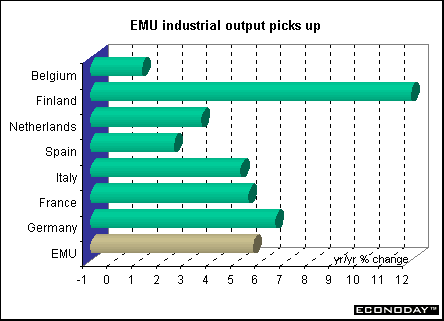
Germany - October Ifo Institute's west German business sentiment index fell to 97.2. This was the fifth monthly decline in a row. The decline in the index was due solely to weaker sentiment on current business conditions, down to 91.3 from 93.2 in September. However, future expectations by west German businesses rose slightly to 103.3 from 103.0, the first monthly increase after four straight declines. East German Ifo was unchanged at 103.8.

October import prices climbed 0.4 percent and 13.4 percent when compared with last year. October's increase was driven by higher prices for consumer and capital goods. Each of those categories rose 0.5 percent from September. Energy goods prices fell by 0.2 percent but surged 77.3 percent when compared with last year. Excluding oil products, import prices rose 0.7 percent on the month and 8.5 percent on the year. Seasonally adjusted import prices rose 0.6 percent and 13.4 percent when compared with last year.
October producer price index rose 0.5 percent and 4.6 percent when compared with last year. The 4.6 percent rate was the highest in 18 years (October 1982). Producer prices excluding petroleum products jumped 0.5 percent and 3.3 percent when compared with last year. Price pressures were evident in durable consumer goods, with prices up 0.4 percent on the month and 1.6 percent when compared with last year. October seasonally adjusted producer prices rose 0.5 percent and 4.6 percent when compared with last year. Excluding energy products, however, seasonally adjusted PPI was unchanged on the month in October, while the annual rate fell to 2.1 percent.
France - Third quarter preliminary seasonally and workday adjusted gross domestic product slowed slightly to 0.7 percent. Household spending rose 0.4 percent, investment growth slowed to 1.5 percent, mainly due to household investment, which rose 0.9 percent. Business investment growth also decelerated to 1.6 percent.
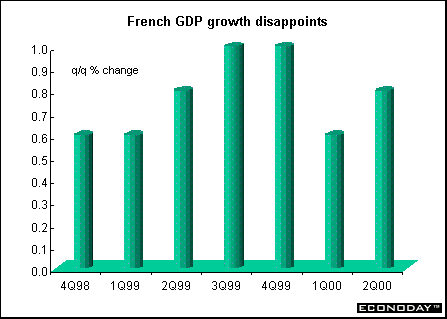
September seasonally and workday adjusted manufacturing output inched up 0.1 percent and 4 percent when compared with last year. Third quarter manufacturing output rose 1.5 percent, well above the 0.3 percent gain posted in the second quarter.
October seasonally and workday adjusted consumer spending on manufactured goods rose 1.5 percent and 3.3 percent on the year. Except for the auto industry, gains were recorded across the board.
Britain - October's budget surplus of 7.4 billion pounds ($10.7 billion) lifted the surplus for the first seven months of the fiscal year to a record, as the economy's expansion boosted tax revenue. In the first seven months of fiscal 2001, the surplus rose to 35.4 billion pounds, five times the surplus in the same period a year earlier. October's surplus was boosted by a 27 percent increase in tax revenue in the month.
Third quarter gross domestic product rose 0.7 percent and 2.9 percent when compared with last year. Consumer spending fueled the rise in GDP, offsetting a large drag on growth from net trade. Household spending jumped one percent and four percent when compared with last year. The biggest drag on growth came from net trade, which depressed the quarterly GDP growth rate after having no effect at all in the second quarter. Service sector growth was up 0.7 percent on the quarter and 3.3 percent on the year. Production output was up 0.6 percent on the month and 1.3 percent on the year. Within this, manufacturing sector output was up 0.6 percent on the quarter and 0.9 percent on the year.
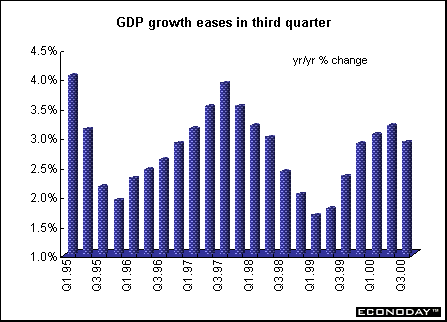
October merchandise trade balance with countries outside the European Union was virtually unchanged from the previous month. The non-EU trade deficit remained broadly stable. In value terms, exports to non-EU countries rose 5.8 percent on the month while imports rose 4.1 percent. The global trade gap widened to Stg2.506 billion in September from Stg2.260 billion in August.
Belgium - October seasonally adjusted Belgian National Bank's composite industry indicator stabilized as improvements in the manufacturing sector, and to a lesser extent in the construction sector, were largely offset by the deterioration in the retail sector. The global indicator rose marginally to plus 1.6, led by the sharp recovery in the manufacturing sector, where the index rose to plus 1.6 from minus 0.1 the month before. The Belgian manufacturing sector is widely seen as a leading cyclical indicator for the EMU, given its concentration on semi-finished goods and the large share of exports to major EMU economies. In recent year's, the central bank's industry indicator has shown a fairly close correlation to EMU industry confidence trends six months later.
Asia
Japan - October seasonally adjusted trade surplus fell 38.2 percent and dropped 40.8 percent when compared with last year. Exports, by value, fell 4.1 percent and were up 8.3 percent from a year earlier. Imports rose 5.8 percent and 27.6 percent from a year ago. By volume, exports rose 2.8 percent from a year earlier as shipments to both the United States and Europe fell. Imports, by volume, rose 16.8 percent. The trade surplus with Asia fell 40 percent in October from year ago. The surplus with the United States rose 4.3 percent but the surplus with Europe fell 27 percent.
September index of tertiary industries fell 1.1 percent but was up 2.4 percent on the year. The all industry index fell 1.5 percent on August and was up 2.3 percent on the year. The tertiary industry activity index, which measures output at restaurants, phone companies and other service providers, rose 0.5 percent the third quarter, less than half the pace of the previous three months. Activity in service industries is closely linked to domestic demand, and accounts for about 60 percent of total economic output.
Hong Kong - October composite consumer price index fell 2.7 percent compared with a 2.6 percent decline in September. The slight acceleration in deflation on the year was mainly because of a larger decrease in housing rentals.
Third quarter seasonally adjusted gross domestic product rose 1.7 percent and 10.4 percent when compared with last year. Exports rose 17.7 percent from a year earlier, matching the previous quarter's increase, and domestic spending gathered pace. Overall investment spending by companies and the government gained 13 percent from a year ago, topping the second quarter's 5.1 percent increase. A pickup in purchases of machinery and equipment offset a drop in construction spending. Consumer spending rose 0.5 percent from the previous quarter, reversing a 0.2 percent decline the previous quarter. From a year ago, spending gained 5.6 percent.
Americas
Canada - October unadjusted consumer price index edged up 0.2 percent. For the second consecutive month, the all items excluding energy index remained unchanged. When compared with last year, consumers paid 2.8 percent more than they did in October 1999. Once again higher energy prices were still the major contributor to the increase to the CPI. Excluding the effect of higher energy prices, the CPI advanced by 1.5 percent between October 1999 and October 2000. The Bank of Canada's inflation target range is one to three percent. October seasonally adjusted CPI inched up 0.1 percent and 2.4 percent when compared with last year. Excluding food and energy, the CPI also rose 0.1 percent but 1.54 percent when compared with last year.

September merchandise trade surplus rose to C$4.3 billion. Exports remained virtually stable as a decline in automotive products nearly offset a strong increase in energy products exports. Energy exports were up 6.5 percent - much of this gain was the result of higher prices - while exports of automotive products declined 2.6 percent. Imports fell 0.7 percent because of a 5.3 percent decline in automotive products imports. The cumulative trade balance with all countries for the first nine months of 2000 was a surplus of C$37.3 billion, up C$12.2 billion from the same period in 1999. The large increase in the trade surplus was a result of higher prices for energy products such as crude petroleum, natural gas and electricity, which pushed up export prices, and lower prices for high technology equipment and computers, which pushed down import prices. Exports to the United States rose 0.6 percent while imports dropped one percent. For the first nine months of 2000, exports leapt 14.8 percent while imports climbed 6.1 percent. Canada has a trade deficit with all other trading partners.
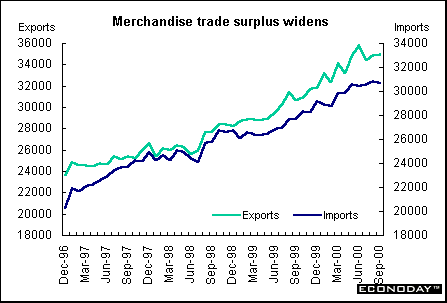
September retail sales rose 0.4 percent. In constant dollars, retail sales remained unchanged Retail sales have been rising for five straight months, although the gains were weaker in September and August. September's retail sales were 6.0 percent higher than those of September 1999. Retail sales advanced 2.9 percent in the third quarter compared with the second. All retail sectors and provinces posted growing sales in the third quarter.
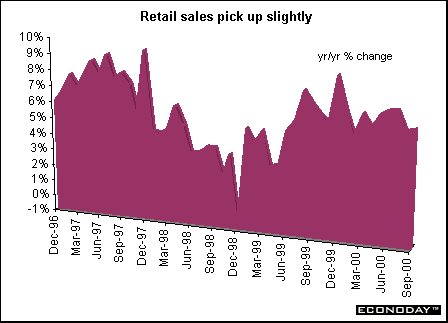


Introduction • Global Stock Market Indexes • Recap of Global Markets • Currencies • Indicator Scoreboard

The Bottom Line • Looking Ahead
© Econoday, 2000. All Rights Reserved.
|